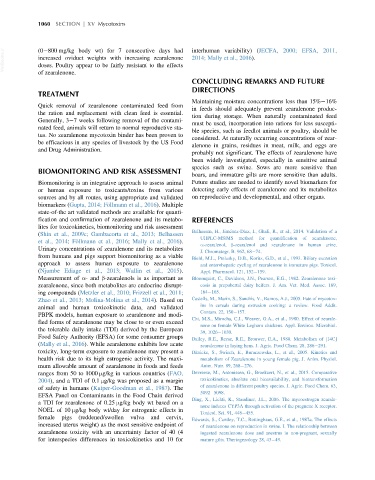Page 1128 - Veterinary Toxicology, Basic and Clinical Principles, 3rd Edition
P. 1128
1060 SECTION | XV Mycotoxins
VetBooks.ir (0 800 mg/kg body wt) for 7 consecutive days had interhuman variability) (JECFA, 2000; EFSA, 2011,
2014; Mally et al., 2016).
increased oviduct weights with increasing zearalenone
doses. Poultry appear to be fairly resistant to the effects
of zearalenone.
CONCLUDING REMARKS AND FUTURE
DIRECTIONS
TREATMENT
Maintaining moisture concentrations less than 15% 16%
Quick removal of zearalenone contaminated feed from
in feeds should adequately prevent zearalenone produc-
the ration and replacement with clean feed is essential.
tion during storage. When naturally contaminated feed
Generally, 3 7 weeks following removal of the contami-
must be used, incorporation into rations for less suscepti-
nated feed, animals will return to normal reproductive sta-
ble species, such as feedlot animals or poultry, should be
tus. No zearalenone mycotoxin binder has been proven to
considered. At naturally occurring concentrations of zear-
be efficacious in any species of livestock by the US Food
alenone in grains, residues in meat, milk, and eggs are
and Drug Administration.
probably not significant. The effects of zearalenone have
been widely investigated, especially in sensitive animal
species such as swine. Sows are more sensitive than
BIOMONITORING AND RISK ASSESSMENT
boars, and immature gilts are more sensitive than adults.
Biomonitoring is an integrative approach to assess animal Future studies are needed to identify novel biomarkers for
or human exposure to toxicants/toxins from various detecting early effects of zearalenone and its metabolites
sources and by all routes, using appropriate and validated on reproductive and developmental, and other organs.
biomarkers (Gupta, 2014; Fo ¨llmann et al., 2016). Multiple
state-of-the art validated methods are available for quanti-
fication and confirmation of zearalenone and its metabo- REFERENCES
lites for toxicokinetics, biomonitoring and risk assessment
Belhassen, H., Jime ´nez-Dı ´az, I., Ghali, R., et al., 2014. Validation of a
(Shin et al., 2009c; Gambacorta et al., 2013; Belhassen
UHPLC-MS/MS method for quantification of zearalenone,
et al., 2014: Fo ¨llmann et al., 2016; Mally et al., 2016).
α-zearalenol, β-zearalenol and zearalenone in human urine.
Urinary concentrations of zearalenone and its metabolites
J. Chromatogr. B. 962, 68 74.
from humans and pigs support biomonitoring as a viable Biehl, M.L., Prelusky, D.B., Koritz, G.D., et al., 1993. Biliary excretion
approach to assess human exposure to zearalenone and enterohepatic cycling of zearalenone in immature pigs. Toxicol.
(Njumbe Ediage et al., 2013; Wallin et al., 2015). Appl. Pharmacol. 121, 152 159.
Measurement of α- and β-zearalenols is as important as Bloomquist, C., Davidson, J.N., Pearson, E.G., 1982. Zearalenone toxi-
zearalenone, since both metabolites are endocrine disrupt- cosis in prepubertal dairy heifers. J. Am. Vet. Med. Assoc. 189,
ing compounds (Metzler et al., 2010; Frizzell et al., 2011; 164 165.
Zhao et al., 2013; Molina-Molina et al., 2014). Based on Castells, M., Marin, S., Sanchis, V., Ramos, A.J., 2005. Fate of mycotox-
ins in cereals during extrusion cooking: a review. Food Addit.
animal and human toxicokinetic data, and validated
Contam. 22, 150 157.
PBPK models, human exposure to zearalenone and modi-
Chi, M.S., Mirocha, C.J., Weaver, G.A., et al., 1980. Effect of zearale-
fied forms of zearalenone may be close to or even exceed
none on female White Leghorn chickens. Appl. Environ. Microbiol.
the tolerable daily intake (TDI) derived by the European
39, 1026 1030.
Food Safety Authority (EFSA) for some consumer groups
Dailey, R.E., Reese, R.E., Brouwer, E.A., 1980. Metabolism of [14C]
(Mally et al., 2016). While zearalenone exhibits low acute zearalenone in laying hens. J. Agric. Food Chem. 28, 286 291.
toxicity, long-term exposure to zearalenone may present a Da ¨nicke, S., Swiech, E., Buraczewska, L., et al., 2005. Kinetics and
health risk due to its high estrogenic activity. The maxi- metabolism of Zearalenone in young female pig. J. Anim. Physiol.
mum allowable amount of zearalenone in foods and feeds Anim. Nutr. 89, 268 276.
ranges from 50 to 1000 μg/kg in various countries (FAO, Devreese, M., Antonissen, G., Broekaert, N., et al., 2015. Comparative
2004), and a TDI of 0.1 μg/kg was proposed as a margin toxicokinetics, absolute oral bioavailability, and biotransformation
of safety in humans (Kuiper-Goodman et al., 1987). The of zearalenone in different poultry species. J. Agric. Food Chem. 63,
5092 5098.
EFSA Panel on Contaminants in the Food Chain derived
Ding, X., Lichti, K., Staudiner, J.L., 2006. The mycoestrogen zearale-
a TDI for zearalenone of 0.25 μg/kg body wt based on a
none induces CYP3A through activation of the pregnene X receptor.
NOEL of 10 μg/kg body wt/day for estrogenic effects in
Toxicol. Sci. 91, 448 455.
female pigs (reddened/swollen vulva and cervix, Edwards, S., Cantley, T.C., Rottinghaus, G.E., et al., 1987a. The effects
increased uterus weight) as the most sensitive endpoint of of zearalenone on reproduction in swine. I. The relationship between
zearalenone toxicity with an uncertainty factor of 40 (4 ingested zearalenone dose and anestrus in non-pregnant, sexually
for interspecies differences in toxicokinetics and 10 for mature gilts. Theriogenology 28, 43 49.

